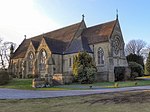Heywood Road
Heywood Road is a multi-use rugby stadium in Sale, Greater Manchester, England, which has been the home ground of rugby union side Sale F.C. since 1905. It was the home ground of spin-off professional club Sale Sharks until they moved to Edgeley Park, Stockport, in 2003. Sale Sharks' 'A' team, the Sale Jets, still play at Heywood Road. From the 2016 season, it has also been home to League 1 (rugby league) team Swinton. The move of Swinton to the ground meant that the General Safety Certificate had to be renewed. In September 2016, a report by Trafford Council to the Safety at Sports Grounds Sub-Committee recommended that Heywood Road's capacity be reduced from 5,400 to 3,387 for safety reasons.
Excerpt from the Wikipedia article Heywood Road (License: CC BY-SA 3.0, Authors).Heywood Road
Willow Tree Court, Trafford Brooklands
Geographical coordinates (GPS) Address External links Nearby Places Show on map
Geographical coordinates (GPS)
| Latitude | Longitude |
|---|---|
| N 53.416111111111 ° | E -2.3213888888889 ° |
Address
Heywood Road
Willow Tree Court
M33 3SE Trafford, Brooklands
England, United Kingdom
Open on Google Maps








